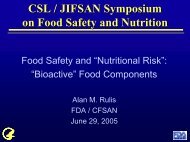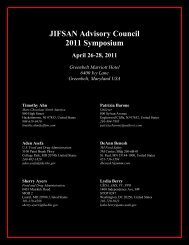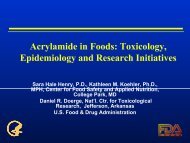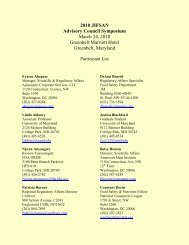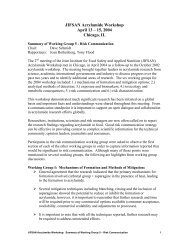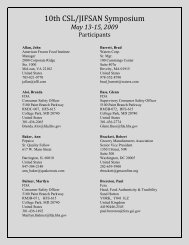PDF (15.73 MB) - jifsan
PDF (15.73 MB) - jifsan
PDF (15.73 MB) - jifsan
You also want an ePaper? Increase the reach of your titles
YUMPU automatically turns print PDFs into web optimized ePapers that Google loves.
CSL/JIFSAN Symposium on Food Safety and Nutrition:<br />
Methods and Systems for Tracking, Tracing, and Verifying Foods<br />
Haile Yancy, Ph.D.<br />
US FDA Center for Veterinary Medicine
• CBOL launched April, 2004.<br />
• Active memberships in 50 countries (and growing).<br />
• Projects to barcode all birds and all fishes on Earth.<br />
• Estimated cost to barcode all animal life: $1 billion.<br />
Guelph
An Internal ID System for All Animals<br />
DNA<br />
The Mitochondrial Genome<br />
D-Loop<br />
Small ribosomal RNA<br />
Cytochrome b<br />
ND6<br />
ND1<br />
Typical Animal Cell<br />
ND5<br />
COI<br />
ND2<br />
mtDNA<br />
H-strand<br />
ND4<br />
L-strand<br />
Mitochondrion<br />
ND4L<br />
ND3<br />
COIII<br />
COII<br />
ATPase subunit 8<br />
ATPase subunit 6
D-<br />
Loop<br />
Small ribosomal<br />
RNA Large<br />
ribosomal<br />
RNA<br />
ND6<br />
ND1<br />
ND5<br />
L-<br />
strand<br />
COI<br />
ND2<br />
H-<br />
strand<br />
ND4<br />
ND4L<br />
ND3<br />
COIII<br />
COI<br />
COII<br />
ATPase subunit<br />
8<br />
ATPase subunit 6
Specimen or Tissue Sample<br />
DNA Barcode<br />
Extract DNA PCR COI Sequence COI
Management and Analysis
Tools Identification Record Links Details Custom Labels
Barcode of Life Data Systems
Tree Based<br />
Identification
Species page
Isoelectric Focusing (IEF)<br />
Protein Fingerprint<br />
Isoelectric focusing protein patterns for the pH<br />
range 3-10 for fresh, frozen, uncooked seafood<br />
based on AOAC 980.16
PCR product<br />
~650 bp<br />
PCR product<br />
~350-250 bp<br />
PCR product<br />
~250- 50 bp
Tuna<br />
Mixed Sample (tuna/catfish)
Copyright ©1994-2009 PREMIER Biosoft International. All rights reserved.
Fish Sample<br />
Allele ID<br />
Oligo<br />
Label<br />
Extract DNA<br />
HYB<br />
…………………………………………..<br />
.....<br />
………………………………………..<br />
…………………………………………<br />
……………………………………………<br />
……………………………………………<br />
……………………………………………<br />
Create Zoo Chip<br />
Identify Species<br />
(Tuna and Ch.<br />
Catfish)
Generally probes are designed at a specific place along a gene sequence<br />
5’ 3’<br />
Available DNA of cooked, processed, or degraded sample<br />
5’ 3’<br />
5’ 3’<br />
Several Probes Designed Along Span of Gene 45-55 nucleotides 5 in length<br />
1 2 3 4 5<br />
5’ 3’
1. Color of spots (specificity)<br />
Negative<br />
Negative (Spotting<br />
Solution Residues)<br />
Positive<br />
2. Ratio of detection (red) to background<br />
(green) fluorescence above 2.0 (sensitivity)
Binding of DNA to Rainbow<br />
Trout Probes<br />
Fluorescence of Rainbow Trout DNA<br />
Rainbow Trout DNA with<br />
Rainbow Trout probes<br />
Channel Catfish DNA with<br />
Rainbow Trout probes<br />
Great Barracuda DNA with<br />
Rainbow Trout probes<br />
Blue Catfish DNA with<br />
Rainbow Trout probes
Pufferfish Primer<br />
PU016: Ct=25.44<br />
Pufferfish Primer<br />
PU050: Ct=25.5<br />
Pufferfish Primer<br />
PU038: Ct=42.7
Left: Florida Southern<br />
Puffer: Ct=22.84<br />
Right: Florida Bandtail<br />
Puffer: Ct=30.7<br />
Left: Florida Checkered<br />
Puffer: Ct=41.54
Figure 1. Primer PU016 was tested against 16 other fish species<br />
closely related to pufferfish to determine specificity. All samples came<br />
up negative
Figure 1. Cooked puffer sample from the soup that caused<br />
the illnesses. Primer PU016 was used. Ct=41.26
A<br />
Regulatory Tool<br />
for the<br />
Third<br />
Millennium





